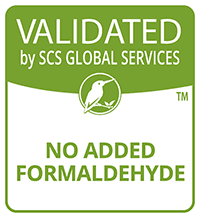Use with Care
Follow our guidelines below if you are interested in using cork, engineered hardwood or bamboo flooring in your home. We can recommend these flooring products only when they are selected carefully, using our parameters for avoiding products made with harmful chemicals or those with negative environmental impacts.
Cork
Suitable for most rooms, including bathrooms and kitchens
Cork flooring is typically suitable for kitchens and bathrooms due to its mold- and moisture- resistant properties. It is also naturally fire retardant, does not adsorb dust, is warm underfoot and provides cushion when standing. It is a natural product made from the bark of cork oak trees, and because harvesting does not damage the tree, it is highly renewable. Cork is as durable as hardwood and can be placed over plywood, concrete or existing flooring as tiles or sheets. And at the end of its life, cork can be composted or recycled.
However, the composition of cork floors can vary widely and may contain harmful binders.
Therefore, when choosing cork flooring, verify that it is:
- Not a cork-vinyl composite with a PVC backing;
- Not made with crumb rubber;
- Not made with carcinogenic isocyanate or formaldehyde binders; and
- Recommended for the parts of the home where it will be used (e.g., bathrooms).
Engineered Hardwood
Suitable for bedrooms and living areas
Engineered hardwood flooring is made up of a top layer of real hardwood veneer adhered to a core of plywood or other wood material. The advantage of engineered hardwood is that it comes pre-finished, making it less labor-intensive to install on-site, and it can be sanded and refinished at least once. The disadvantage is that the glues and wood composite materials may contain formaldehyde.
Therefore, when choosing engineered hardwood flooring, make sure to carefully select a product that meets the following criteria:
- FSC certified;
- formaldehyde-free glues; and
- low-VOC or Green Seal 11-certified finish.
Bamboo
Bamboo is a rapidly growing, renewable material that can be harvested every three to five years. Some types of bamboo are harder than oak and can last 30 to 50 years. But some bamboo harvesting practices are unsustainable and contribute to deforestation, and few bamboo products are currently FSC certified.
Additionally, bamboo flooring is composed of glued strips, and until recently, all bamboo floors contained formaldehyde-based glues. Some replacement glues can also contain isocyanates, which can cause respiratory irritation and sensitization that can result in severe asthma.
If, after considering other alternatives, you still have your heart set on bamboo flooring, make sure to carefully select a product that meets the following criteria:
- FSC certified;
- formaldehyde-free glues; and
- low-VOC or Green Seal 11-certified finish.






